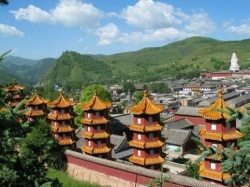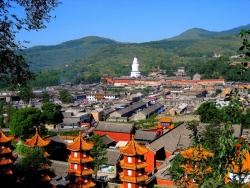More on Wutai Mountain China
Wutai Mountain plays an important role in Buddhist history. From the time of Yongping (58 – 75 A.D.) in the East Han, the emperors of China began choosing Wutai Mountain as the place to build temples. Forty-seven of these ancient monasteries still exist. Among them the lamaseries are preserved the best, such as Nan Shan Si (The Temple on the South Hill), Zhen Hai Si (The Temple for Prostrating the Sea), Guang Ren Si (The Temple of Great Benevolence), and Pu Sa Ding (The Top of Bodhisattve).
Nan Shan Si (The Temple on the South Hill) was set up in the Yuan Dynasty. At that time it was named The Grand Temple of Blessing the Country. In the Qing Dynasty and the period of the Republic of China, more and more buildings were added. Now with dozens of courtyards, the temple stretched over the hillside. Inside the courtyards, stone stairs link the lanterns, palaces and stone bridges, over pools and springs. The unusual trees and flowers, the hidden entrances and pathways, and smaller yards interlinking inside the larger ones make the temple charming, deep and serene.
In the temple there is the Da Xiong Bao Dian (Jeweled Palace of the Great Hero)in which jade images of Bodhisattva, Avalokitesvara as well as the Eighteen Lohans are enshrined. The horizontal inscription board by Qing Empress Dowager Cixi hangs on the Meditation Room in the yard behind the Da Xiong Bao Dian.
Zhen Hai Si (The Temple for Prostrating the Sea) is located between two hills, surrounded by old trees and wild flowers. By it floods a spring that, according to legend, is an eye of the sea. The temple was built here in order to prostrate the sea; otherwise it would cause disasters.
In the courtyard of the temple stands a stone monument with the inscriptions by Qing Emperor Kangxi in 1711. Zhen Hai Si is also famous for its Pagoda of Kntuchtu XV, Kntuchtu Drang Ca who died in Beijing during the reign of Qing Wikipedia:Emper Qianlong|Emper Qianlong]]]]. His relics were buried in the temple and the Pagoda was built for him. Its magnificence surprises all the visitors.
Guang Ren Si (Guan The Temple of Great Benevolence) was built during the reign of Qing Emperor Daoguang for Mongolian and Tibetan Lamas to live when pilgrimaging on Wutai Mountain. One of the differences between it and the other temples in the Mountain is that its 1200 figures of Buddha including Sakyamuni are bronze.
The portrait of Panchen Erdenis X enshrined by the Lamas is hung in the Palatial Hall. In the Back Hall, thousand volumes of Tibetan scriptures written during the Ming and Qing Dynasty are kept in the color glass bookcases.
Besides the religious settings, there is a clinic and a shop in the lamasery which are run by the Lamas and the Tibetan doctors from Gansu. The goods sold here come from Lhasa by air, such as Buddha statues and ornamental articles, are good in quality and not expensive.
The Top of Bodhisattva is the lead lamasery in Wutai Mountain, and one of the five large areas for Meditation there. Sitting on the top of Ling Jiu Feng (The Hill of Intelligent Vulture), the building is composed of 400 rooms with glazed-tile roofs. From the foot of the steep hill a stone ladder of 108 steps that looks like it is touching the heaven leads to the lamasery.
Along a wooden archway leading to the lamasery, there are imperial monuments with inscriptions by Emperor Kangxi and Qianlong. The highest one is 6 meters high, inscribed by Qianlong. On its four sides, each a meter wide, inscriptions are carved in Chinese, Mongolian, Manchu and Tibetan.
Tibetan Buddhism originated in the Yuan Dynasty. Emperor Kublai Khan was a devout believer in Tibetan Buddhism. Tibetan Lamas therefore were greatly empowered and from then on Tibetan lamaseries appeared on Wutai Mountain. In the Ming and Qing Dynasty the emperors carried out the same religious policy. They not only reconstructed and fixed old lamaseries but also transformed some temples into lamaseries. For instance, [Pu Sa Ding]], established originally during the reign of Emperor Xiaowen (471 – 477A.D.), was reconstructed and became a lamasery at the beginning of the reign of Ming Emperor Yongle.
Everything in the center of Taihuai Town makes you feel like you are in Lhasa. The houses standing under the sunlight are Tibetan style, shinning with white, flat roofs. The Lamas are mostly from Tibet. They wear woolen maroon robes, baring their shoulders. It is easy for them to get used to the weather here because of the high elevation of Wutai Mountain. The Lamas are well educated, honest, sincere and forthright. They teach the same as they do in Tibet. In Guang Ren Si I meet a child Lama about ten years old. In the clinic he has a bed on which are picture books in Chinese and Tibetan. Obviously he comes here as a student learning from the Lama doctors, whose medical skill is spoken highly of.
The Lamas lead an active life. Everyday they receive a many visitors from all over the country and abroad. Some are students of Buddhism, others are excursionists. The lamaseries offer a window on Tibet, allowing more and more people to learn about Tibetan civilization and how Buddhist culture influenced the development of Tibet.
With more and more hotels, restaurants and shops opening in Taihuai Town, Wutai Mountain is changing. Pilgrimage and tourism bring much need income into Wutai County, a developing area in Shanxi Province. But there are problems also. First of all, there is a shortage of money to repair the temples, although some approaches are taken to raise funds. There are many dirty stalls with crowds of people selling odds-and-ends and other souvenirs. The noise from the exhibitions, together with the smoke given out by the hotels burning coal makes visitors sick.


